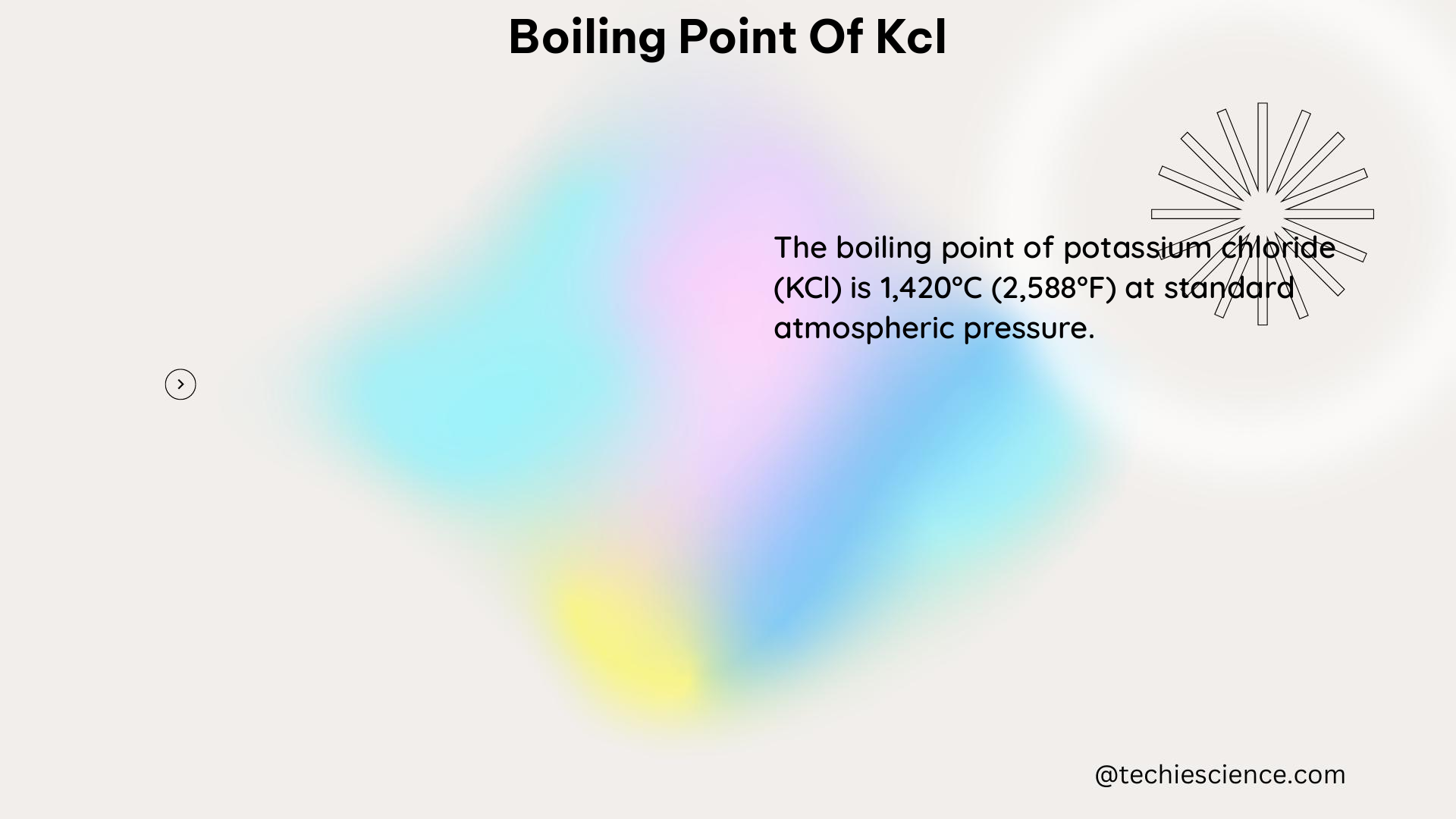The boiling point of potassium chloride (KCl) is a crucial parameter in various chemical and industrial processes, from water treatment to the production of fertilizers. This comprehensive guide delves into the intricacies of KCl’s boiling point, providing a wealth of technical details, practical applications, and hands-on experiments to help you gain a deeper understanding of this essential property.
Understanding the Boiling Point of KCl
The boiling point of KCl is not a fixed value but rather a variable that depends on the concentration of the solution. This relationship is governed by the boiling point elevation equation, which states that the boiling point of a solution is directly proportional to the molality of the solute.
The boiling point elevation equation is expressed as:
ΔTb = Kb × m
Where:
– ΔTb is the change in boiling point (in °C)
– Kb is the ebullioscopic constant for water (0.512°C·kg/mol)
– m is the molality of the solution (mol/kg)
This means that as the concentration of KCl in the solution increases, the boiling point will also rise. For example, the addition of 1 mole of KCl to 1 kg of water raises the boiling point by 3.014°C.
Factors Affecting the Boiling Point of KCl

Concentration of KCl
The concentration of KCl in the solution is the primary factor that determines the boiling point. As the molality of KCl increases, the boiling point of the solution rises accordingly.
Presence of Other Solutes
The presence of other solutes, such as potassium sulfate (K2SO4), can also affect the boiling point of KCl. Studies have shown that the addition of a small amount of K2SO4 (molar fraction from 0.05 to 0.20) can increase the vapor pressure of KCl by up to 1.2 times, which in turn affects the boiling point of the solution.
Atmospheric Pressure
The boiling point of KCl, like any other substance, is also influenced by the atmospheric pressure. As the pressure decreases, the boiling point of KCl will also decrease, and vice versa.
Technical Specifications of the Boiling Point of KCl
Boiling Point Elevation Equation
The boiling point elevation equation, as mentioned earlier, is the primary tool used to calculate the change in boiling point of a KCl solution:
ΔTb = Kb × m
Where:
– ΔTb is the change in boiling point (in °C)
– Kb is the ebullioscopic constant for water (0.512°C·kg/mol)
– m is the molality of the solution (mol/kg)
Using this equation, we can determine the boiling point of a KCl solution with a known concentration.
Boiling Point of a 1 Molal KCl Solution
The boiling point of a 1 molal solution of KCl is approximately 100.5°C.
Boiling Point of a KCl and K2SO4 Solution
The boiling point of a solution containing both KCl and K2SO4 can be calculated using the relative pressure of KCl in the mixture. The vapor pressure of KCl on the top surface of the condensed phase dominates the mass loss rate of KCl from molten salts. The mass loss rate (m·KCl, kg/s) is given by the equation:
m·KCl = A × DKCl,gas × LFV × MKCl × (p0 – pKCl,0) / (R × T)
Where:
– A is the surface area of the condensed phase (m²)
– DKCl,gas is the diffusion coefficient of KCl in gas (m²/s)
– LFV is the height of the free volume in a crucible (m)
– MKCl is the molar mass of KCl (kg/mol)
– p0 is the pressure of the atmosphere (Pa)
– pKCl,0 is the vapor pressure of KCl at the top surface of the condensed phase (Pa)
– R is the universal gas constant (J/(mol·K))
– T is the temperature of the sample (K)
By using this equation, you can calculate the boiling point of a KCl and K2SO4 solution based on the relative pressure of KCl in the mixture.
Measuring the Boiling Point of KCl: A DIY Experiment
To measure the boiling point of KCl, you can perform a simple experiment using a thermometer, a heat source, and a container of KCl solution. Here’s a step-by-step guide:
- Prepare a KCl solution of known concentration.
- Heat the solution slowly while stirring.
- Record the temperature of the solution as it approaches the boiling point.
- Once the solution begins to boil, record the temperature.
- Repeat the experiment with solutions of different concentrations to observe the effect on the boiling point.
Remember to control the temperature and volume of the solution for accurate results.
Conclusion
The boiling point of potassium chloride (KCl) is a complex and variable property that depends on various factors, including the concentration of the solution, the presence of other solutes, and atmospheric pressure. By understanding the technical specifications and practical applications of KCl’s boiling point, you can gain valuable insights into its behavior and effectively utilize this knowledge in a wide range of chemical and industrial processes.
References
- Boiling Point of KCl
- Boiling Point Elevation
- Calculating Moles of KCl Added
- Vapor Pressure of KCl in Molten Salts

The lambdageeks.com Core SME Team is a group of experienced subject matter experts from diverse scientific and technical fields including Physics, Chemistry, Technology,Electronics & Electrical Engineering, Automotive, Mechanical Engineering. Our team collaborates to create high-quality, well-researched articles on a wide range of science and technology topics for the lambdageeks.com website.
All Our Senior SME are having more than 7 Years of experience in the respective fields . They are either Working Industry Professionals or assocaited With different Universities. Refer Our Authors Page to get to know About our Core SMEs.